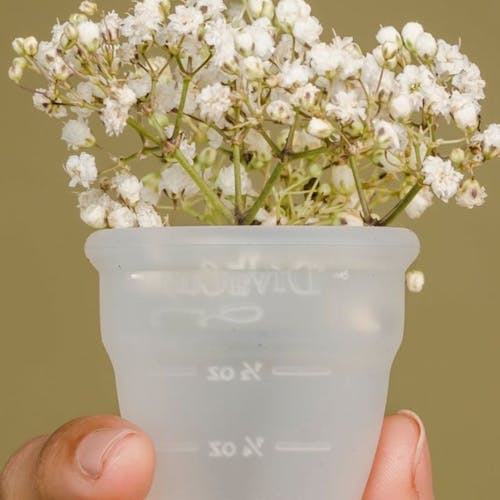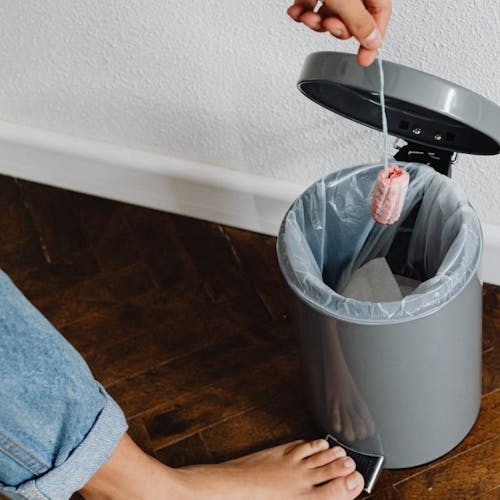This website uses cookies to enhance the user experience. By using Yoppie you are agreeing to our use of cookies.
The Great Debate: Tampons vs. Menstrual Cups
Written by Yoppie
01 Jun 2020
Which is easier to insert and remove?
What about the ick-factor?
Which is more leak-proof?
And lastly… which is more eco-friendly?
So… are you tampon-loyal or a menstrual cup convert? Cups have gained popularity in recent years, but have never become as mainstream and common as tampons for dealing with periods. Everyone has their own preference, but let’s break down the pros and cons of both. Here we go...
Which is easier to insert and remove?
Ease-of-use is an important factor to consider, and using a menstrual cup takes some getting used to. Before you even get to inserting a cup, you should decide on the right size (this is usually determined by your age, and can change very slightly if you’ve ever given birth) and thoroughly wash your hands before you start. Apply a water-based lubricant if necessary, fold the cup in half with the rim facing up, then insert as you would a tampon. Then, twist to open inside the vagina, creating a seal.
To remove, wash your hands again and insert an index finger and thumb into your vagina to find the stem of the cup. Pull down gently until you can feel the base, then pinch the base to release the seal and pull down to fully remove.
This takes practice, which is why many people prefer the easy option; tampons. Though washing your hands first is still recommended, inserting a tampon is usually as simple as pushing it in and... voila! No fiddling around with seals and pinching. Just grab the string and gently pull to remove.
What about the ick-factor?
The general gross-ness that comes to mind when thinking of menstrual cups is one of the main reasons why some people avoid them. You have to be OK with potentially getting a little blood on your hands when you change it because menstrual cups should always be cleaned thoroughly before being reinserted into the vagina. Plus, there’s the issue of getting rid of the collected blood (and other stuff!) when rinsing it out.
Most people will dump the blood down the toilet and wash their cup in the sink, but when you’re in a public bathroom this can pose a slight problem. In this instance, tampons are sometimes the preferred option as they can be disposed of in the feminine hygiene bins you’ll find in public toilets.
Which is more leak-proof?
Studies have found menstrual cups to be just as reliable as tampons for preventing embarrassing leaks, but it’s important to know that in both cases leaks can happen.
The same risks of overflow apply for both, but when using a menstrual cup there is the added possibility of leakage due to using the wrong size of cup, incorrect placement, or even unusual genital or uterine anatomy rendering the cup ineffective. The best way to avoid a leak, in any case, is knowing the optimal time to change or remove your chosen period product.
Both tampons and menstrual cups can lead to TSS (toxic shock syndrome) if not changed regularly. Most tampon packaging will recommend changing every 4 - 8 hours, while a menstrual cup can often be left in for 6 - 12 hours depending on your flow. This makes it useful for overnight protection, too. Remember there is still a risk of TSS when using a cup, so follow the instructions, change regularly, and always remove at the end of your period.
A review of menstrual cups found that while they are safe to use, there is a lack of evidence around the risk of infection which could affect their safety. It’s rare, but sometimes bugs on your hands can be transferred to the cup during insertion (hence the importance of washing those hands!). This can lead to conditions like yeast infections and bacterial vaginosis. To avoid this, users should always wash their cup with warm water and a fragrance-free soap before every use.
A review of menstrual cups found that while they are safe to use, there is a lack of education around the risk of infection which could affect their safety. It’s rare, but sometimes bacteria on your hands is transferred to the cup during insertion (hence the importance of washing those hands!). This can lead to conditions like yeast infections and bacterial vaginosis. To avoid this, users should always wash their cup with warm water and a fragrance-free soap before every use.
Lastly, fibre shedding is very common when using traditional tampons, as during insertion and removal, friction between the tampon and your vaginal wall can loosen fibres which get left behind. Yoppie's organic tampons are created with a ‘security veil’ to avoid this but menstrual cups also offer an option that tidies up after itself before leaving your vagina!
And lastly… which is more eco-friendly?
The biggest advantage of menstrual cups is their eco-friendly nature. Menstrual cup manufacturers differ in their suggestions for how often you should replace your cup, citing anywhere from 6 months to 10 years. We think a safe bet is once a year, to ensure you’re being environmentally-friendly and not throwing away unnecessary plastic, but still reducing risk of infection by not holding on to a cup that’s years old.
There are eco-friendly tampon options out there (like us of course - all natural cotton, biodegradable, and no plastic in sight!) but menstrual cups tend to be a much more eco-friendly option than supermarket brand tampons, which are disposable. We’d like to think of Yoppie as the best of both worlds; combining all the body-safe, eco-friendly bits of a cup alongside with the ease of a tampon!
Have you tried both options? Or are you tempted to switch to a cup? Let us know your thoughts over on Instagram @itsyoppie. If you're not ready to make the switch to a cup, or want some backup ready for your knickers, don't forget that our personalised period subscription box can get organic cotton pantyliners, and much more, delivered easily and regularly through your letterbox. That's one less thing to worry about!
Fact checked by Doctor Samantha Miller.
Section jump
Back to top
Subscribe To Our Newsletter
YOPPIE





© 2026 Yoppie is a registered trademark of Phlo Technologies Ltd.
Yoppie's supplements are not a substitute for a varied diet and healthy lifestyle and are not intended to diagnose, treat, or cure any disease. If you are pregnant, breastfeeding, have a medical condition or are under medical supervision, please consult with your doctor before taking any of our products.






